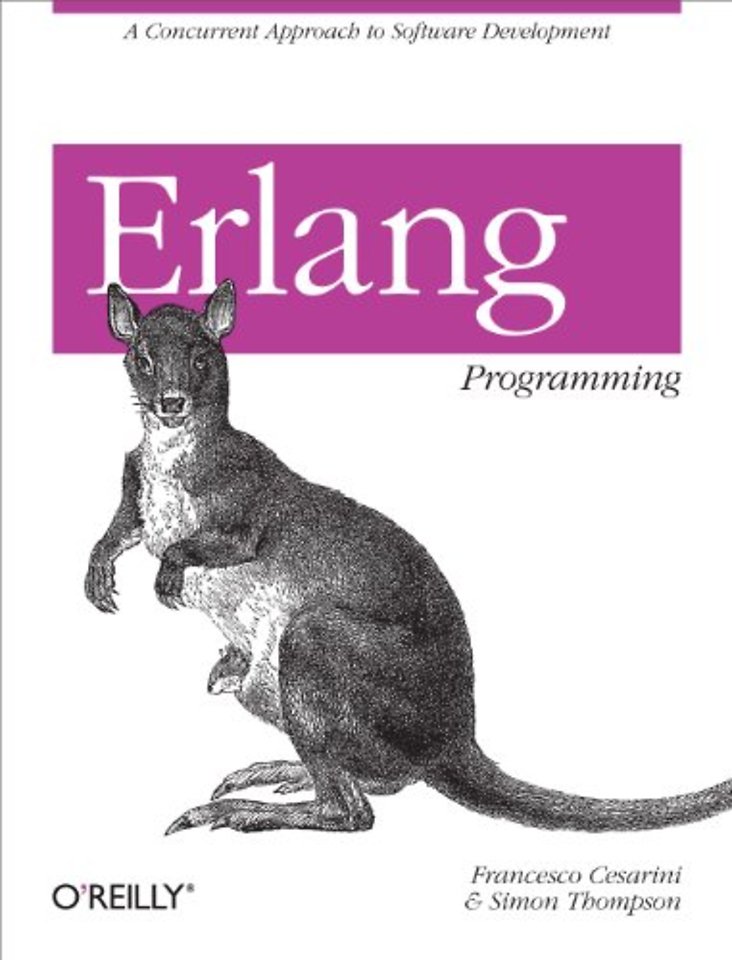Erlang Programming
Paperback Engels 2009 9780596518189Samenvatting
This book is an in-depth introduction to Erlang, a programming language ideal for any situation where concurrency, fault tolerance, and fast response is essential. Erlang is gaining widespread adoption with the advent of multi-core processors and their new scalable approach to concurrency. With this guide you'll learn how to write complex concurrent programs in Erlang, regardless of your programming background or experience.
Written by leaders of the international Erlang community -- and based on their training material -- Erlang Programming focuses on the language's syntax and semantics, and explains pattern matching, proper lists, recursion, debugging, networking, and concurrency.
This book helps you:
Understand the strengths of Erlang and why its designers included specific featuresLearn the concepts behind concurrency and Erlang's way of handling itWrite efficient Erlang programs while keeping code neat and readableDiscover how Erlang fills the requirements for distributed systemsAdd simple graphical user interfaces with little effortLearn Erlang's tracing mechanisms for debugging concurrent and distributed systemsUse the built-in Mnesia database and other table storage features
Erlang Programming provides exercises at the end of each chapter and simple examples throughout the book.
Specificaties
Lezersrecensies
Inhoudsopgave
Preface;
Francesco: Why Erlang?;
Simon: Why Erlang?;
Who Should Read This Book?;
How to Read This Book;
Conventions Used in This Book;
Using Code Examples;
Safari® Books Online;
How to Contact Us;
Acknowledgments;
Chapter 1: Introduction;
1.1 Why Should I Use Erlang?;
1.2 The History of Erlang;
1.3 Erlang’s Characteristics;
1.4 Erlang and Multicore;
1.5 Case Studies;
1.6 How Should I Use Erlang?;
Chapter 2: Basic Erlang;
2.1 Integers;
2.2 The Erlang Shell;
2.3 Floats;
2.4 Atoms;
2.5 Booleans;
2.6 Tuples;
2.7 Lists;
2.8 Term Comparison;
2.9 Variables;
2.10 Complex Data Structures;
2.11 Pattern Matching;
2.12 Functions;
2.13 Modules;
2.14 Exercises;
Chapter 3: Sequential Erlang;
3.1 Conditional Evaluations;
3.2 Guards;
3.3 Built-in Functions;
3.4 Recursion;
3.5 Runtime Errors;
3.6 Handling Errors;
3.7 Library Modules;
3.8 The Debugger;
3.9 Exercises;
Chapter 4: Concurrent Programming;
4.1 Creating Processes;
4.2 Message Passing;
4.3 Receiving Messages;
4.4 Registered Processes;
4.5 Timeouts;
4.6 Benchmarking;
4.7 Process Skeletons;
4.8 Tail Recursion and Memory Leaks;
4.9 A Case Study on Concurrency-Oriented Programming;
4.10 Race Conditions, Deadlocks, and Process Starvation;
4.11 The Process Manager;
4.12 Exercises;
Chapter 5: Process Design Patterns;
5.1 Client/Server Models;
5.2 A Process Pattern Example;
5.3 Finite State Machines;
5.4 Event Managers and Handlers;
5.5 Exercises;
Chapter 6: Process Error Handling;
6.1 Process Links and Exit Signals;
6.2 Robust Systems;
6.3 Exercises;
Chapter 7: Records and Macros;
7.1 Records;
7.2 Macros;
7.3 Exercises;
Chapter 8: Software Upgrade;
8.1 Upgrading Modules;
8.2 Behind the Scenes;
8.3 Upgrading Processes;
8.4 The .erlang File;
8.5 Exercise;
Chapter 9: More Data Types and High-Level Constructs;
9.1 Functional Programming for Real;
9.2 Funs and Higher-Order Functions;
9.3 List Comprehensions;
9.4 Binaries and Serialization;
9.5 References;
9.6 Exercises;
Chapter 10: ETS and Dets Tables;
10.1 ETS Tables;
10.2 Dets Tables;
10.3 A Mobile Subscriber Database Example;
10.4 Exercises;
Chapter 11: Distributed Programming in Erlang;
11.1 Distributed Systems in Erlang;
11.2 Distributed Computing in Erlang: The Basics;
11.3 The epmd Process;
11.4 Exercises;
Chapter 12: OTP Behaviors;
12.1 Introduction to OTP Behaviors;
12.2 Generic Servers;
12.3 Supervisors;
12.4 Applications;
12.5 Release Handling;
12.6 Other Behaviors and Further Reading;
12.7 Exercises;
Chapter 13: Introducing Mnesia;
13.1 When to Use Mnesia;
13.2 Configuring Mnesia;
13.3 Transactions;
13.4 Partitioned Networks;
13.5 Further Reading;
13.6 Exercises;
Chapter 14: GUI Programming with wxErlang;
14.1 wxWidgets;
14.2 wxErlang: An Erlang Binding for wxWidgets;
14.3 A First Example: MicroBlog;
14.4 The MiniBlog Example;
14.5 Obtaining and Running wxErlang;
14.6 Exercises;
Chapter 15: Socket Programming;
15.1 User Datagram Protocol;
15.2 Transmission Control Protocol;
15.3 The inet Module;
15.4 Further Reading;
15.5 Exercises;
Chapter 16: Interfacing Erlang with Other Programming Languages;
16.1 An Overview of Interworking;
16.2 Interworking with Java;
16.3 C Nodes;
16.4 Erlang from the Unix Shell: erl_call;
16.5 Port Programs;
16.6 Library Support for Communication;
16.7 Linked-in Drivers and the FFI;
16.8 Exercises;
Chapter 17: Trace BIFs, the dbg Tracer, and Match Specifications;
17.1 Introduction;
17.2 The Trace BIFs;
17.3 Tracing Calls with the trace_pattern BIF;
17.4 The dbg Tracer;
17.5 Match Specifications: The fun Syntax;
17.6 Match Specifications: The Nuts and Bolts;
17.7 Further Reading;
17.8 Exercises;
Chapter 18: Types and Documentation;
18.1 Types in Erlang;
18.2 TypEr: Success Types and Type Inference;
18.3 Documentation with EDoc;
18.4 Exercises;
Chapter 19: EUnit and Test-Driven Development;
19.1 Test-Driven Development;
19.2 EUnit;
19.3 The EUnit Infrastructure;
19.4 Testing State-Based Systems;
19.5 Testing Concurrent Programs in Erlang;
19.6 Exercises;
Chapter 20: Style and Efficiency;
20.1 Applications and Modules;
20.2 Processes and Concurrency;
20.3 Stylistic Conventions;
20.4 Coding Strategies;
20.5 Efficiency;
20.6 And Finally...;
Using Erlang;
Getting Started with Erlang;
Tools for Erlang;
Where to Learn More;
Colophon;
Rubrieken
- advisering
- algemeen management
- coaching en trainen
- communicatie en media
- economie
- financieel management
- inkoop en logistiek
- internet en social media
- it-management / ict
- juridisch
- leiderschap
- marketing
- mens en maatschappij
- non-profit
- ondernemen
- organisatiekunde
- personal finance
- personeelsmanagement
- persoonlijke effectiviteit
- projectmanagement
- psychologie
- reclame en verkoop
- strategisch management
- verandermanagement
- werk en loopbaan

